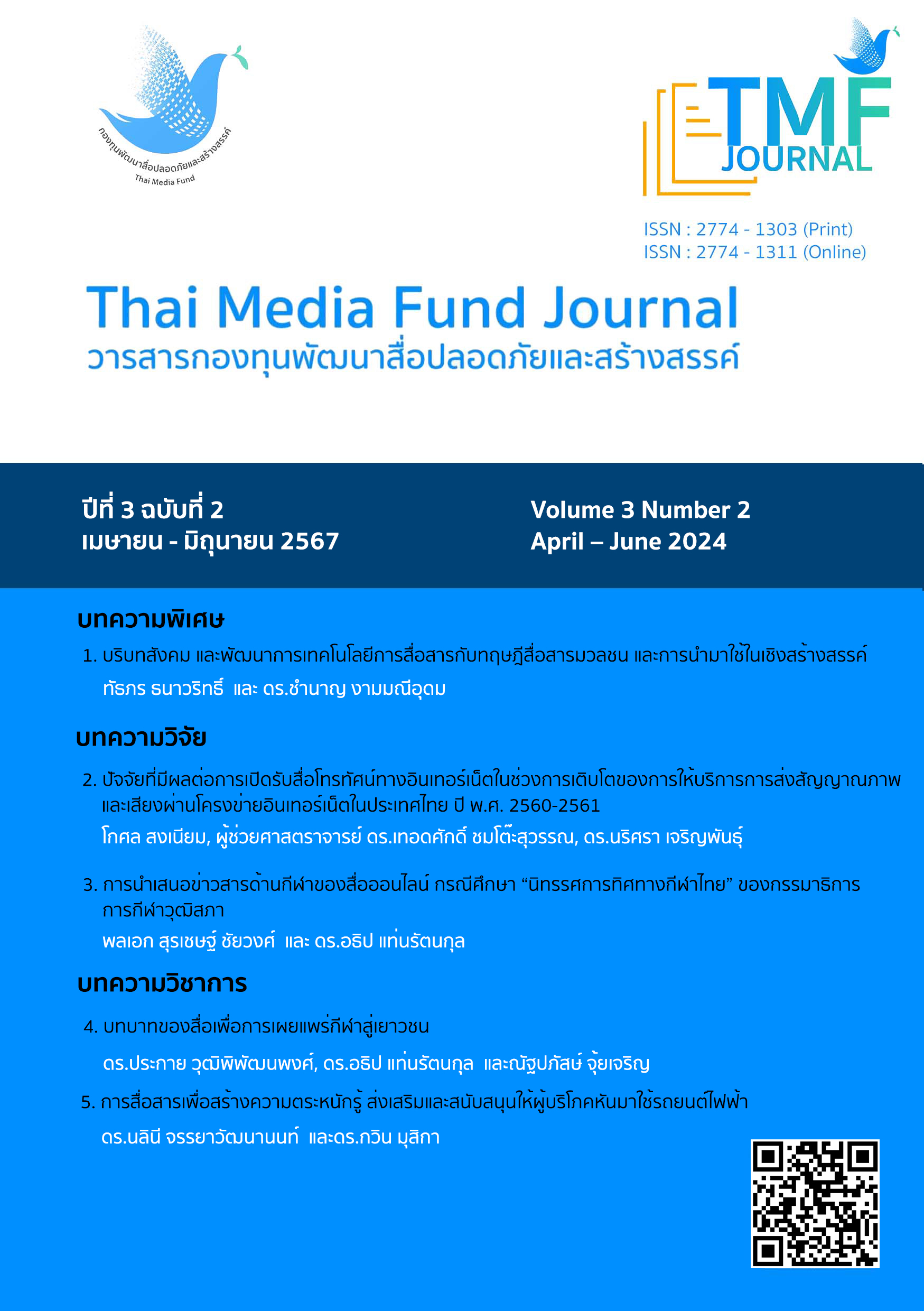Factors Affecting Exposure to Internet Televisions during the Growth of OTT Services in Thailand between 2017-2018
Main Article Content
Abstract
This research investigated the phenomena and factors influencing the adoption of over-the-top (OTT) television services via the internet among households in Thailand during 2017-2018, compared to the present (2024). A mixed methods approach was employed, utilizing secondary data from the National Statistical Office's 2017-2018 Household Television Viewing Devices Survey (n=429,648) and in-depth interviews with 6 experts from the television broadcasting and telecommunications industries. Qualitative analysis and Quantitative analysis involved logit modeling and examining relationships among independent variables.
The findings revealed a exponential surge in public internet usage, aligned with the proliferation of 4G mobile networks and residential fixed broadband internet rollouts. This coincided with the decline of digital terrestrial TV broadcasting, where audiences had a multitude of options to access content on-demand across platforms and times. This drove transformations in OTT television viewing behaviors that diverged from 2017-2018 norms, with demographic differences observed in gender, age, and education levels compared to that period. Income and internet costs remained influential factors. While smart TV ownership facilitated OTT adoption, these platforms exhibited greater complexity and accessibility barriers versus mobile viewing. Consequently, wireless cellular networks experienced more rapid expansion for OTT consumption compared to fixed broadband to accommodate this increasing untethered streaming demand.
Article Details

This work is licensed under a Creative Commons Attribution-NonCommercial-NoDerivatives 4.0 International License.
References
Anantho, S. (2021). Current status and future prospects of OTT service in Thailand. Journal of Business Administration and Social Sciences Ramkhamhaeng University. 4(3),
-130
Chanvisatlak, P. (2018). New media innovation in the booming social media era with the adaptation of television. Journal of Faculty of Journalism and Mass Communication. 11(1), 223-245
Datareport.com. (2018, January 30). Digital 2018: Global digital overview. Retrieved December 17, 2023, from https://datareportal.com/reports/digital-2018-global-digital-overview
ETDA. (2022). Thailand internet user behavior 2022. Retrieved Jun 6, 2023 form https://www.etda.or.th/getattachment/78750426-4a58-4c36-85d3-d1c11c3db1f3/IUB-65-Final.pdf.aspx
Kaewkhum, N., & Benjarongkij, Y. (2020). Television Industry and its Role in the New Media Landscape Under the System of Digital Economy. Journal of Communication Arts, 39(1), 107-120.
Kidsom, A. (2018). Affordability of fixed line household high speed internet in Thailand. MUT Journal of Business Administration 15(2), 89-110.
Limparungpatanakij, A. (2018, October 16). Restructuring the television industry For the future of Thailand 4.0. Retrieved December 17, 2023 from www.komchadluek.net/scoop/299098
Ministry of Digital Economy and Society. (2021). Project to upgrade telecommunications infrastructure, Activity 1: Expansion of high-speed internet networks nationwide to support domestic economic development (Net Pracharat Project). Retrieved June 6, 2023, from https://www.mdes.go.th/mission/detail/416
NBTC. (2020). NBTC office announces 5G spectrum auction results. Retrieved Jun 6, 2023 form https://www.nbtc.go.th/News/ Information/40146.aspx?lang=th-th
NBTC. (2021). Thailand’s OTT Market Overview 2020. Retrieved Jun 6, 2023 form https://broadcast.nbtc.go.th/ data/ott/[Infographic]%20Thailand%27s%20OTT.pdf
NBTC. (2023). Thai television media ecosystem and regulatory guidelines in the streaming era (1st ed.). Bangkok: Chula Unisearch.
NSO. (2018). Explore the availability of viewing devices household television programs in 2018 (Quarter 1). Bangkok: NSO.
Thairath Online. (2019, April 11). Section 44 helps digital TV get its license back. No need to pay the auction fee in 2 installments, supporting 3 mobile phone companies. Retrieved April 11, 2019 from https://www.thairath.co.th/money/economics/thailand_econ/1542465
Time Consulting. (2022, January 1). OTT TV, the future of television viewing. Retrieved from https://www.timeconsulting.co.th/ ott-tv-อนาคตแห่งการชมโทรทัศน์
Wongrujira, M. (2022). OTT TV services and challenges in the television industry. Journal of Communication Arts Sukhothai Thammathirat Open University, 12(2), 26-34.


